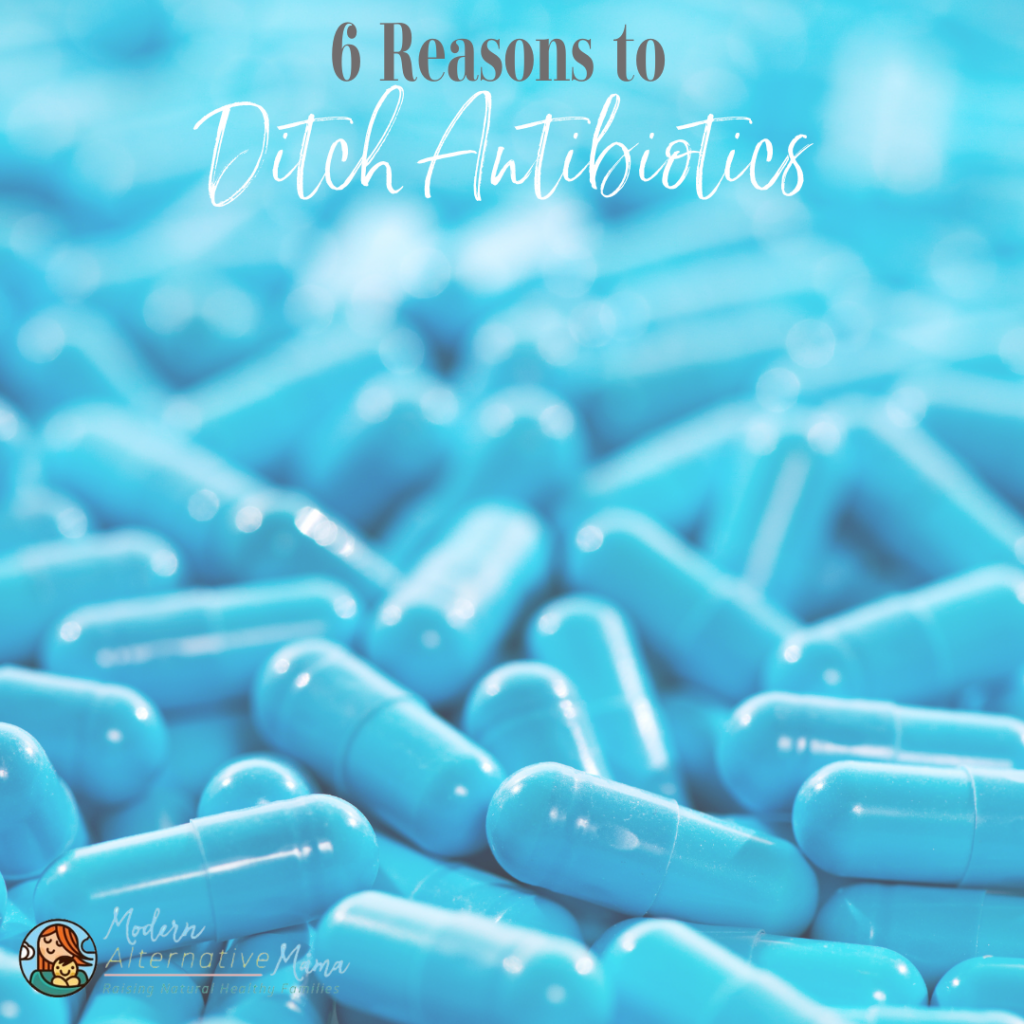By Danielle, Contributing Writer
They are the most prescribed pharmaceutical in the United States. When you bring your child into the pediatrician with anything from a cold to the flu, you will likely end up leaving with an antibiotic in hand; regardless if the illness is bacterial or not. We fill the prescription, thinking we’ve done our due diligence as parents, and our little one is better in days.
Statistics show that as many as four out of five Americans are prescribed antibiotics each year. But, is it really helping our health? Or should you ditch antibiotics…for good?
6 Reasons Why You Should Ditch Antibiotics (For Good)
#1 They Don’t Really Help
First, consider that most of the ills you’re bringing your babe in for are actually viruses, for which an antibiotic will not help at all. But, your doctor will still likely prescribe them so that they can say they “did something,” and that you didn’t leave empty-handed.
Even if you can verify that the illness is bacterially-derived, because antibiotics are so overused, their effectiveness is waning. Couple that with the fact that if you do not get the exact antibiotic strain for the bacteria causing the sickness, and the exact right dosage, it may not even work. In fact, it may cause more harm than good.
Basically, the chances that an antibiotic is going to resolve your bacterial illness is close to the likelihood that your husband will fix that fence. Don’t count on it.
#2 They Damage Gut Health, and Increase the Chance of Another Bacterial Infection
Antibiotics (literally meaning anti-life) kill all your good bacteria, which make up most of your immune system in your gut. Antibiotics will obliterate that, and cause imbalance between the good and bad bacteria. This will allow the bacterial illness you were sick with in the first place to take over your good bacteria, and recurrent infections as well as deteriorating health will follow. If you’ve already used antibiotics, probiotics can build back up your good bacteria.
#3 They Can Cause Serious Allergic Reactions
We think that the only “common” reaction is to penicillin, but a severe allergic reaction to antibiotics, possibly leading to a lifetime of autoimmune disease is possible. In addition to the antibiotic strain, you may also be mildly or severely allergic to an ingredient in the antibiotic, such as sulfur.
Unfortunately, reactions are grossly underreported, so we cannot say how many children and adults are truly allergic, or experience serious side effects. Other research has shown there is a possible correlation between antibiotic use and allergies..
#4 They are Over-Prescribed
The CDC itself admits that at least 30% of all antibiotic prescriptions are unnecessary. There are over 150 million prescriptions written for antibiotics yearly in the United States. As stated above, these are usually for viral illnesses, so antibiotics are no help. A rule of thumb when determining if an illness is bacterial or viral is that bacterial illnesses will be local, one organ or one area of the body and more serious (worse feeling, higher, longer-lasting fever); whereas viral illnesses will likely be an overall sick feeling.
#5 Super Bugs
Need I say more?
Now, every time you enter the hospital, your biggest worry is not even your illness. It’s the antibiotic-resistant superbugs, which are next to impossible to kill (with Western medicine). MRSA, C diff, and CRE are just three of these killers, and you can actually check how many antibiotic resistant infections occurred at your hospital each year (which I suggest you do if you need to be admitted). At least 23,0000 Americans are killed per year by superbugs. This is directly due to over-prescription and the use of antibiotics on the animals we eat.
#6 There are Safer, More Effective Natural Alternatives
Nature knows best. In a study by Washington State University, garlic was found to be 100 times more effective than two popular antibiotics. Some of the most popular are garlic, onion, turmeric, ginger, cayenne, Echinacea, cinnamon, and olive leaf extract.
So, the next time you suspect a bacterial illness, try these natural remedies instead, and let your doctor know you’re asking for more than a throw-a-dart-at-the-wall prescription for your $150 appointment.








Great article! My son will be 3 soon and has ever been on any antibiotics. I have not been on any for several years. I was overprescribed them as a child growing up in Canada and ruined my gut health. I will avoid them at all costs for me and my family.
[…] that works for your family. Build up your child’s good bacteria with pre and probiotics, do not use antibiotics, and ensure your home is not lending to a bacterial […]
[…] toxins and allergens from the diet, not an external cream. This can be caused by a vaccine, antibiotic, gluten or dairy intolerance, and GMOs and pesticides; but is typically a mix of all of those […]
[…] and the health of our gut depends on the health of our bacteria in there. Delivering naturally, avoiding antibiotics, and adding probiotics will boost your child’s biome immensely. If you are particularly concerned […]
[…] detox that works for your family. Build up your child’s good bacteria with pre and probiotics, do not use antibiotics, and ensure your home is not lending to a bacterial […]
[…] 10 Ways to Get Your Home Dirtier (With Good Bacteria) #1 Ditch the Antibiotics […]